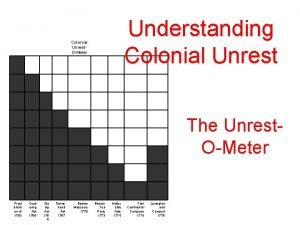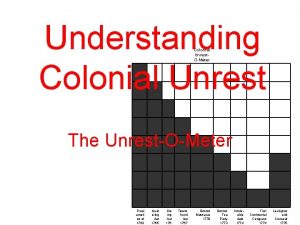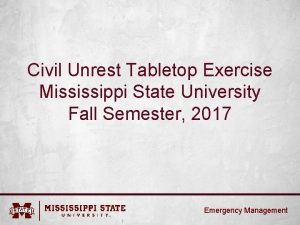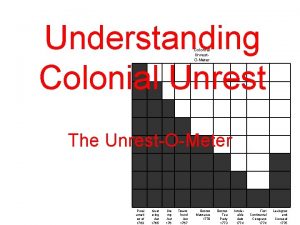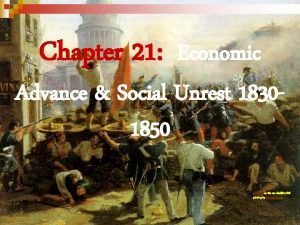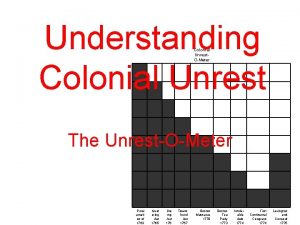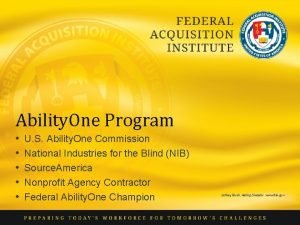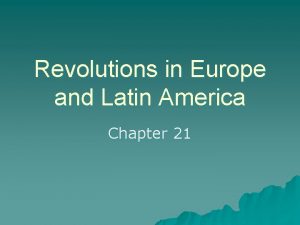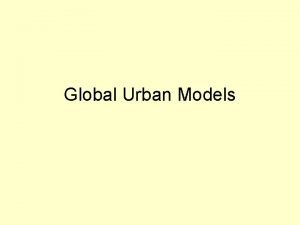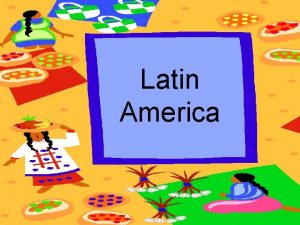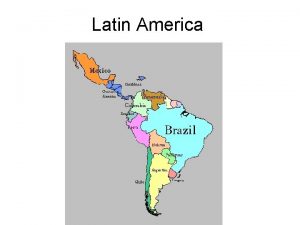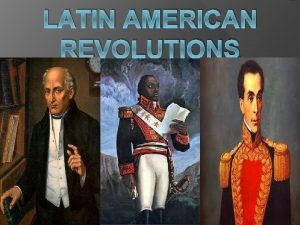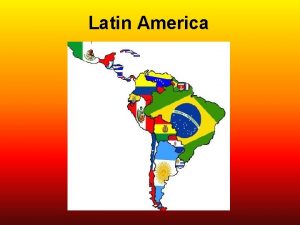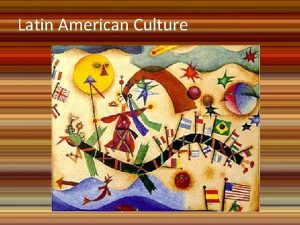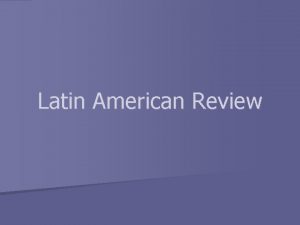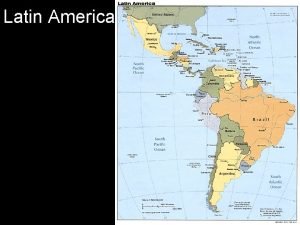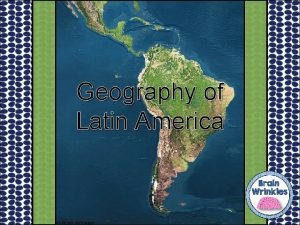UNREST THROUGHOUT LATIN AMERICA Source of Unrest throughout














- Slides: 14

UNREST THROUGHOUT LATIN AMERICA

Source of Unrest throughout Latin America is a diverse region with a great variety of peoples and cultures. Geographic barriers have discouraged unity, yet the nations of Latin America share similar problems. After World War II, political and social upheavals threatened stability in Latin America. Many Latin American nations looked to authoritarian leaders to provide solutions.

Cuba had won independence from Spain in 1898. Over the next 60 years, Cuba was influenced by the United States. In 1952, Fulgencio Batista seized power. Under Batista the government was repressive and corrupt. Fidel Castro organized a guerrilla army and fought a war against Batista, gaining victory in 1959.

Cuba Once in power, Castro established a communist dictatorship. Heavily supported by the Soviet Union, Cuba was a cold war battle ground until the collapse of communism in the Soviet Union and Eastern Europe. Cuba’s economy has since suffered greatly form the loss of its chief trading partners.

Mexico After the Mexican Revolution, one party the Institutional Revolutionary Party (PRI) dominated Mexican politics for 71 years. Between 1960 and 2000 there were periods of upheaval. In 1986, students in Mexico protested. The police and military brutally suppressed the protests. In 1994, armed Indian Zapatista rebels demanded social and economic reforms. Many groups called for election reforms. In 200, the PRI lost and Vicente Fox from the National Action Party (PAN) was elected president.

Panama In the 1980 s, the United States suspected that the leader of Panama, Manuel Noriega was helping drug lords smuggle drugs into the United States. US troops invaded in 1989 and arrested Noriega. Panama experienced greater stability in the 1990 s.

North American Free Trade Agreement In the 1990 s, Mexico, the US, and Canada signed the North American Free Trade Agreement (NAFTA) which is a plan to allow free trade among the three nations by lowering trade barriers. Business and investment did come to Mexico, but other manufactures were hurt by competition. Immigration provides a link between Mexico and the US. Since the 1970 s, millions of Mexicans have migrated to the US, in search of better economic opportunities.

POLITICAL AND ECONOMIC CHANGE IN LATIN AMERICA

Argentina By 1900 Argentina was the richest nation in Latin America. The Great Depression of the 1930 s devastated the country and a military coup brought Juan Perón to power in 1946. Perón appealed to Argentine nationalism by limiting foreign-owned businesses and by promoting import substitution, in which local manufacturers produced goods at home to replace imported products. Perón gained popularity by boosting wages, strengthening labor unions, and beginning social welfare programs however, this led to huge debts. In 1955 he lost power in a military coup.

State Terrorism -Another military government took control in 1976. This government began a program of state terrorism against leftist guerrilla groups. The military arrested, tortured, and killed thousands of people. As many as 20, 000 people simply “disappeared”, this is known as the dirty war.

Democracy Restored –In 1983, Argentina held elections. Voters returned a democratic government to power. The new government worked to control the military and restore human rights. However, economic problems persisted. In 2001, and economic crisis rocked the nation and the hardship led to widespread protests and continued instability.

Chile In 1970, Salvador Allende, a Communist, was elected president. He introduced land reform measures and nationalized copper mines, which were largely American-owned. In 1973, Allende was assassinated by the Chilean military, led by General Augusto Pinochet, who established a repressive military dictatorship.

Nicaragua The Somoza family governed Nicaragua. The Somoza’s were repressive but had close ties to the United States because of their anti -communist stance. In 1979, the Sandinistas, a group that included both reform-minded nationalists and communists, overthrew the Somoza government.

The Sandinistas in Power The Sandinistas set up a government under the leadership of Daniel Ortega. The government introduced reforms while growing closer to Cuba and other communist nations. In the 1980 s, the Sandinistas faced opposition form the contras, a counterrevolutionary group. The United States secretly backed the contras. Civil war followed, leading to many deaths and weakening the economy. Through compromises the Sandinistas handed over power to freely elected president, Violeta Chamorro. Nicaragua still had to rebuild its economy.
 Why is called latin america
Why is called latin america Proclamation of 1763
Proclamation of 1763 Colonial unrest-o-meter
Colonial unrest-o-meter Civil unrest tabletop exercise
Civil unrest tabletop exercise Colonial unrest-o-meter
Colonial unrest-o-meter Giuseppe mazzini
Giuseppe mazzini Colonial unrest-o-meter
Colonial unrest-o-meter Rap of the map of the us
Rap of the map of the us America asia africa
America asia africa Whats an onomatopeia
Whats an onomatopeia Happening e performance
Happening e performance Ability one commission
Ability one commission Revolutions in europe and latin america section 2 quiz
Revolutions in europe and latin america section 2 quiz Latin city model
Latin city model Bolivia christmas food
Bolivia christmas food

